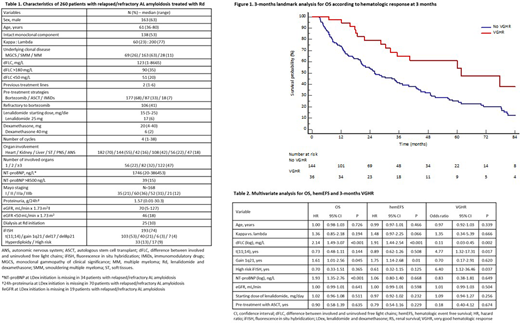Introduction: Lenalidomide and dexamethasone (Rd) is an effective, but rather toxic rescue treatment in relapsed/refractory AL amyloidosis (RRAL). The increase of NT-proBNP that frequently occurs under LDex hampers the assessment of cardiac disease, while renal toxicity can result in end stage renal failure. We report 260 patients with RRAL treated with Rd with a long median follow-up (4.7 years) and an evaluation of cytogenetic abnormalities by fluorescence in situ hybridization (iFISH) in 193 cases.
Methods: Data were collected from the prospectively maintained database of the Heidelberg Amyloidosis Center. With the exception of iFISH data, variables were all collected at the last evaluation before starting Rd. Patients received lenalidomide (days 1-21) and dexamethasone (days 1, 8, 15 and 22) in a 28-days cycle. Lenalidomide dose was adjusted according to clinical status and renal function (median starting dose 15 mg; range: 5-25 mg). Patients received thrombosis prophylaxis with acetylsalicylic acid (100 mg/day) or heparin. Hematologic response was assessed by intent to treat at 3 months after treatment initiation as per validated criteria (Palladini, et al. JCO 2012). In cases with a baseline difference between involved/uninvolved light chains (dFLC) <50 mg/L, response was defined according to low-dFLC response criteria (Dittrich, et al. Blood 2017). A very good hematologic response (VGHR) was defined as the achievement of very good partial response or better, including low dFLC-response. Cardiac progression was defined as per current criteria (Palladini, et al. JCO 2012). Overall survival (OS) and hematologic event free survival (hemEFS) were evaluated from Rd initiation. Multivariate Cox regression analysis was used for identification of prognostic factors.
Results: Patients characteristics are reported in Table 1. The most frequent cytogenetic aberrations were t(11;14) and gain 1q21. Adverse events (AEs) were observed in 130 of 260 (50%) patients and resulted in treatment discontinuation in 55 (21%) and dose reduction in 42 (16%) cases. Hematologic response was observed in 62/197 (31%) patients at 3 months, with a VGHR in 18% of cases. Hematologic response rate was not significantly different in patients pre-treated with autologous stem cell transplant (ASCT, 37% vs. 28%, P=0.269) or refractory to bortezomib (30% vs. 40%, P=0.333). After a median follow-up of 56 months, 166 (64%) subjects died. Median OS and hemEFS were 32 and 9 months, respectively. In a 3-months landmark analysis, achieving a VGHR resulted in a better OS (62 vs. 26 months, P<0.001 Figure 1). Cardiac progression, was observed in 60% of cases at 3 months and resulted in worse OS (22 vs. 40 months, P=0.019). Renal progression was present in 31% of evaluable patients at 3 months. Progression to dialysis was observed in 31 cases, with a rate of 10% at 1-year and 15% at 2-years after LDex initiation. Multivariate analysis was performed in patients in with available iFISH data, including other factors like age, clonal and organ biomarkers, R starting dose and ASCT pretreatment (n=166; Table 2). Gain 1q21 resulted as an independent prognostic factor for hemEFS (HR 1.75, P=0.01), along with dFLC (HR 1.91, P<0.001). Gain 1q21 was also able to predict OS (HR 1.61, P=0.045), along with dFLC (HR 2.14, P<0.001) and NT-proBNP (HR 1.93, P<0.001). Three-months VGHR was independently predicted by dFLC (OR 0.11, P=0.002). Interestingly, harbouring high risk cytogenetics (i.e. del17, t(4;14) and t(14;16)) or t(11;14) was associated with higher VGHR rate at 3 months.
Conclusion: Achieving a VGHR with LDex is not frequent at 3 months but results in long OS (median >5 years). Patients with clonal plasma cells harbouring gain 1q21, higher dFLC or NT-proBNP have a worse survival. AEs were frequent (50% of patients), resulting in treatment discontinuation in 1/5 of cases. Almost 1/3 of patients had a worsening of renal function, resulting in progression to dialysis in 15% of cases at 24 months. Cardiac progression defined by NT-proBNP results in significantly shorter OS. Therefore, it should be assessed carefully and be considered for treatment change along with no hematologic response. This information should be kept in mind, since novel and promising results are coming from the association with Rd with ixazomib or daratumumab. This could result in a novel and wider role of lenalidomide in treatment of AL amyloidosis.
Goldschmidt:Amgen: Honoraria, Membership on an entity's Board of Directors or advisory committees, Other: Grants and/or provision of Investigational Medicinal Product, Research Funding; Adaptive Biotechnology: Membership on an entity's Board of Directors or advisory committees; GlaxoSmithKline (GSK): Honoraria; University Hospital Heidelberg, Internal Medicine V and National Center for Tumor Diseases (NCT), Heidelberg, Germany: Current Employment; BMS: Honoraria, Membership on an entity's Board of Directors or advisory committees, Other: Grants and/or provision of Investigational Medicinal Product:, Research Funding; Celgene: Honoraria, Membership on an entity's Board of Directors or advisory committees, Other: Grants and/or provision of Investigational Medicinal Product:, Research Funding; Chugai: Honoraria, Other: Grants and/or provision of Investigational Medicinal Product:, Research Funding; Dietmar-Hopp-Foundation: Other: Grants and/or provision of Investigational Medicinal Product:; Janssen: Honoraria, Membership on an entity's Board of Directors or advisory committees, Other: Grants and/or provision of Investigational Medicinal Product:, Research Funding; Johns Hopkins University: Other: Grants and/or provision of Investigational Medicinal Product; Sanofi: Honoraria, Membership on an entity's Board of Directors or advisory committees, Other, Research Funding; Incyte: Research Funding; Molecular Partners: Research Funding; Merck Sharp and Dohme (MSD): Research Funding; Mundipharma GmbH: Research Funding; Takeda: Membership on an entity's Board of Directors or advisory committees, Research Funding; Novartis: Honoraria, Research Funding. Mueller-Tidow:Pfizer: Membership on an entity's Board of Directors or advisory committees, Research Funding; Daiichi Sankyo: Research Funding; BiolineRx: Research Funding; Janssen-Cilag Gmbh: Membership on an entity's Board of Directors or advisory committees; Deutsche Forschungsgemeinschaft: Research Funding; Deutsche Krebshilfe: Research Funding; BMBF: Research Funding; Wilhelm-Sander-Stiftung: Research Funding; Jose-Carreras-Siftung: Research Funding; Bayer AG: Research Funding. Schönland:Janssen, Prothena, Takeda: Honoraria, Other: travel support to meetings, Research Funding.
Author notes
Asterisk with author names denotes non-ASH members.


This feature is available to Subscribers Only
Sign In or Create an Account Close Modal